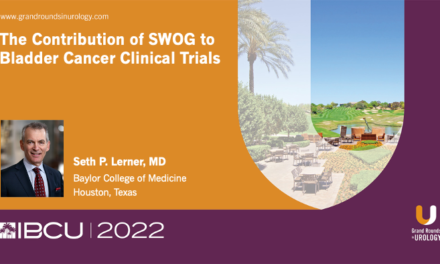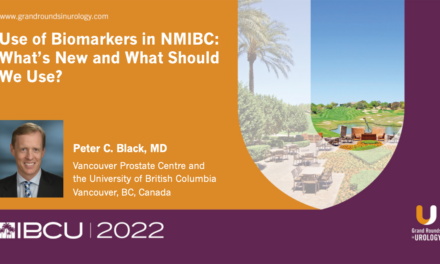Peter Black, MD, FACS, FRCSC, presented “Bladder Sparing Regimens for Muscle Invasive Disease: Should We Be Doing this More?” at the 6th International Bladder Cancer Update on November 18, 2022, in Scottsdale, Arizona.
How to cite: Black, Peter. “Bladder Sparing Regimens for Muscle Invasive Disease: Should We Be Doing this More?” November 2022. Accessed Jun 2025. https://grandroundsinurology.com/bladder-sparing-regimens-for-muscle-invasive-disease-should-we-be-doing-this-more/
Bladder Sparing Regimens for Muscle Invasive Disease: Should We Be Doing this More? – Summary
Peter Black, MD, FACS, FRCSC, Khosrowshahi Family Chair and Professor in the Department of Urologic Sciences at the University of British Columbia (UBC) in Vancouver, discusses the merits of radiation-based, bladder-sparing therapies for muscle-invasive bladder cancer (MIBC). He reviews the bladder-sparing treatment modalities, including surgery (e.g., transurethral resection of bladder tumor [TURBT], partial cystectomy), radiation (e.g., radiation therapy/ trimodal therapy [RT/TMT]), and systemic therapy (e.g., TURBT with chemotherapy). He then explains that RT is a spectrum that includes palliative and “high-grade” palliation, radical radiation, and TMT, which includes TURBT as a critical component, external-beam radiation therapy (EBRT), and concurrent chemotherapy. Dr. Black explains that TMT promises equivalence of outcome to radical cystectomy (RC). He then outlines “the 10 commandments” of TMT, including that organ preservation is common in other organ sites, RC is morbid, 50 percent of patients do not receive curative-intent therapy, TMT is a surgical approach, long-term results of TMT are excellent and comparable to RC (in the “optimal” patient), concurrent chemotherapy is important, the long-term toxicity of TMT is acceptable, superficial recurrences can be managed conservatively, TMT is supported by guidelines, and TMT is a biomarker-driven management approach for MIBC. Dr. Black defines the characteristics of the optimal TMT patient before turning to the issue of carcinoma in situ (CIS), explaining that expert consensus says that while extensive or multifocal CIS is a contraindication for TMT, focal CIS adjacent to MIBC is not a major barrier to TMT. Dr. Black emphasizes that MIBC patients are undertreated and recommends practitioners be more balanced with respect to TMT, acknowledging what he calls a critical gap in expertise and experience across multidisciplinary team members. He discusses TMT delivery, including completeness of TURBT, use of fiducial marker, schedule (continuous vs. split), and selection of chemotherapy. Dr. Black explains that complete TURBT improves outcomes. He recommends, and explains the process of, injecting fiducial markers to enable image-guided radiation to accommodate bladder motion since bladder position changes each day. Dr. Black outlines two options for the delivery of TMT, then highlights the importance of concurrent chemotherapy, citing a prospective randomized UK trial that showed better outcomes with chemoradiotherapy than radiotherapy alone. He reminds fellow practitioners that patients ineligible for cisplatin should receive an alternative concomitant therapy (such as 5-FU + mitomycin, gemcitabine, or carbogen and nicotinamide [though this one is not currently used in North America]), emphasizing that local disease control and survival is inferior with RT only. Dr. Black addresses the role of neoadjuvant chemotherapy before TMT, concluding that, although there was one negative U.S. trial, international data support its use. He discusses ongoing studies addressing concurrent/adjuvant immunotherapy with TMT before turning to a comparison of outcomes between TMT and RC. Dr. Black cites a multi-institutional study and explains data showing favorable outcomes with TMT vs. RC. He explains that literature suggests equivalent outcomes for “optimal” patients, with the caveat that much of that literature is derived from clinical trials and few specialized centers with a limited sample size. He emphasizes the importance of shared decision-making, reminding practitioners that some patients may opt to accept some risk to avoid RC. Dr. Black closes with his take-home messages for practitioners: discuss TMT as an option for patients with MIBC, consider neoadjuvant chemotherapy in patients planning to undergo TMT, and consider alternative chemotherapy in cisplatin-ineligible patients.
About the 6th International Bladder Cancer Update:
The International Bladder Cancer Update (IBCU) is a CME conference focused on the diagnosis and treatment of bladder cancer. The conference offers medical professionals an opportunity to listen to updates from, and interact with, expert international faculty to improve knowledge and determine best treatment practices to improve patient outcomes. IBCU encompasses expert lectures, interactive discussions, a panel roundtable, debates, and case presentations. It is physician-led, multi-supported, and designed for urologists, urologic oncologists, and other healthcare professionals involved in the treatment of bladder cancer.
For further educational activities from this conference, visit our collection page.
ABOUT THE AUTHOR
Dr. Peter Black is a urologic oncologist at Vancouver General Hospital, a research scientist at the Vancouver Prostate Centre, and a Professor in the Department of Urologic Sciences at the University of British Columbia (UBC). He received his undergraduate degree from UBC and his medical degree from Johannes Gutenberg University in Mainz, Germany. He completed his urologic training at the University of Washington in Seattle and a Fellowship in Urologic Oncology at MD Anderson Cancer Center in Houston, Texas. He has a clinical subspecialty interest in bladder cancer. He maintains a grant-funded translational research program in urothelial carcinoma and is an active cancer clinical trialist in this field.



